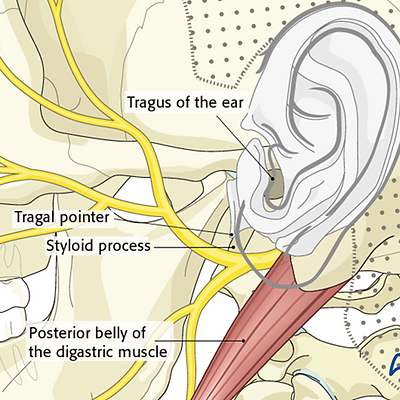
Facial nerve disorders
What are facial nerve disorders?
The facial nerve controls the movement of one side of the face; it has an important role in eye movement, facial expression, eating and drinking. The facial nerve courses through the side of the face, which makes it susceptible to involvement by head and neck cancers. It can also be involved by non-cancer conditions like viral infections (Bell’s palsy or Ramsay-Hunt syndrome) or stroke. This weakness can occur suddenly or gradually.
What are the signs and symptoms?
These can be subtle, such as inability to completely close the eyelids, or obvious, such as deviation or drooping of one side of the face. There may also be tearing of the affected eye, redness or pain, inability to control the lower lip while eating leading to leaking of food, and spasmodic uncontrolled movements of the facial muscles, known as ‘synkinesis’. There can also be a loss of control over facial expression.
How are they diagnosed?
Your surgeon can diagnose facial nerve weakness after a clinical examination. By asking you to move various muscles of your face, they will be able to tell which ones are affected. Additional testing for more detailed information includes:
Electromyography (EMG): This measures the electrical activity in the muscles and the transmission of the current through the nerve. It can provide information on the degree of damage and the likelihood of recovery of nerve function.
CT or MRI scans: These can identify structural damage to the nerve from cancer or other causes, and are helpful in planning treatment
How are they treated?
For reversible causes of facial nerve weakness, like Bell’s palsy, the treatment may be a short course of medications, like steroids and antivirals. Specific physical therapy to strengthen your facial muscles may also hasten recovery. In cases where there is irreversible facial nerve damage or unavoidable sacrifice as part of the cancer therapy, ‘facial reanimation’, a group of surgeries aimed to improve facial nerve function or facial symmetry, is indicated. Some of the treatments that achieve this goal are facial nerve repair, cable grafting, temporalis tendon transfer, modified selective neurectomy, botox injection and eyelid weights.
Can they be completely cured?
Many patients, such as those with Bell’s palsy can be completely cured over time. Depending on the severity and complexity of the nerve injury, the likelihood of complete recovery can vary. The earlier the treatment, the better the outcome. Even when the facial nerve function cannot be completely restored, there are a range of surgical and non-surgical procedures that can improve facial function, reduce suffering and prevent complications of facial nerve palsy (like corneal exposure). It is important to get evaluated by a team of specialists who can determine what the best treatment plan is for you.
